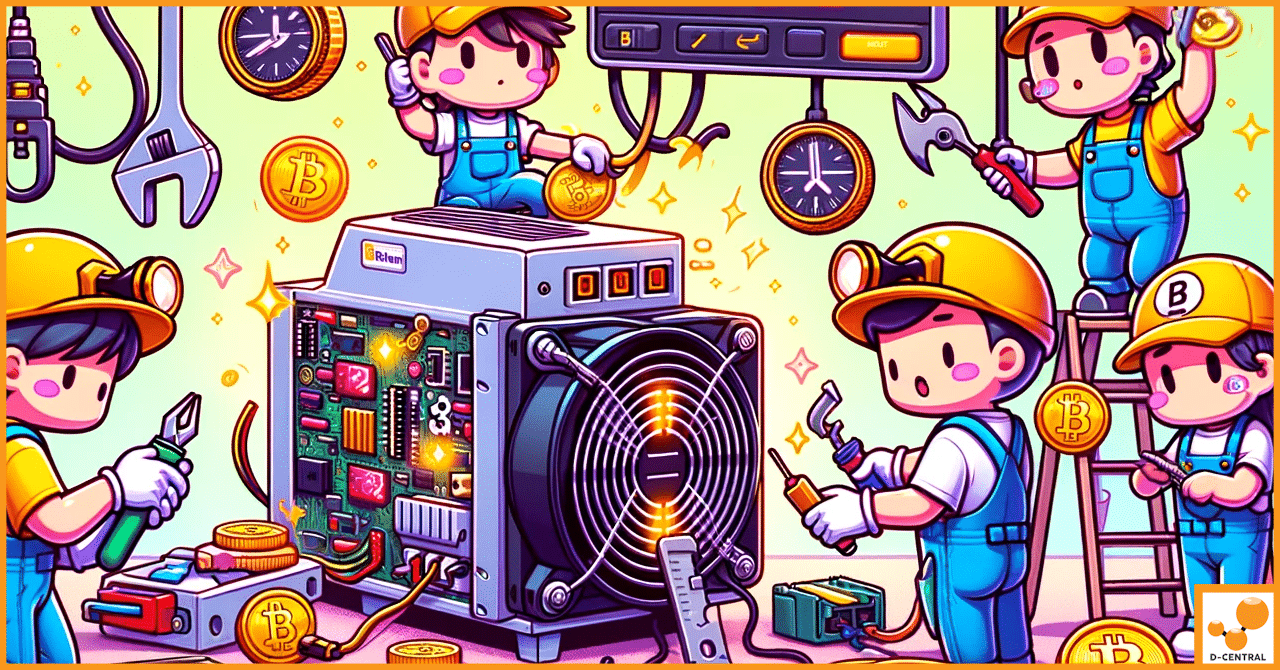
Fixing Bitmain’s Antminer Red Light Flashing Problem in 5 Minutes
In the dynamic world of cryptocurrency mining, Bitmain’s Antminer stands out as a beacon of efficiency and reliability. Launched by
4479 Desserte Nord Autoroute 440, Laval, QC H7P 6E2

In the dynamic realm of cryptocurrency, Application-Specific Integrated Circuit (ASIC) mining has emerged as a cornerstone, powering the blockchain with unparalleled efficiency. ASIC miners, specialized hardware designed exclusively for cryptocurrency mining, have revolutionized the way digital currencies like Bitcoin are mined. Unlike their predecessors—CPUs, GPUs, and FPGAs—ASIC miners offer a quantum leap in processing power and energy efficiency, making them indispensable for serious miners aiming to stay competitive in the ever-evolving mining landscape.
However, the superior performance of ASIC miners comes with its own set of challenges, chief among them being the need for meticulous maintenance. The concept of maintenance in ASIC mining transcends mere routine checks; it is a critical operational practice that directly impacts the longevity, efficiency, and profitability of mining operations. In the high-stakes world of cryptocurrency mining, where every second counts and downtime equates to lost revenue, maintenance is not just a recommended activity—it’s an essential strategy for ensuring that mining rigs operate at their peak performance.
This introduction to ASIC mining and the pivotal role of maintenance sets the stage for a deeper exploration into why regular upkeep is not just beneficial but necessary for anyone invested in the mining process. From combating dust accumulation and managing cooling systems to updating software and troubleshooting hardware issues, effective maintenance practices can mean the difference between a profitable mining operation and one that struggles to keep pace with the network’s demands. As we delve into the intricacies of ASIC miner maintenance, it becomes clear that in the fast-paced world of cryptocurrency mining, proactive maintenance is the key to unlocking sustained success and maximizing the return on investment in this cutting-edge technology.
Regular maintenance of ASIC miners is not just a good practice; it’s the backbone of a successful mining operation. These high-powered machines, while designed for durability and efficiency, operate under intense conditions that can lead to wear and tear, overheating, and eventual breakdown if not properly cared for. The importance of ASIC miner maintenance lies in its direct impact on the machines’ optimal performance and longevity, ensuring that miners can continue to contribute to the blockchain effectively and profitably over time.
ASIC miners are engineered to perform complex cryptographic calculations at high speeds, a process that generates significant heat and stress on the hardware. Without regular maintenance, dust accumulation, thermal paste degradation, and fan failure can impede airflow and cooling, leading to overheating. Overheating not only reduces the efficiency of the miners but can also cause permanent damage to the components, shortening their operational lifespan. By adhering to a maintenance schedule that includes cleaning, replacing thermal paste, and ensuring that cooling systems are functioning optimally, miners can prevent these issues, thereby safeguarding their investment and extending the life of their equipment.
The profitability of ASIC mining operations hinges on two critical factors: the efficiency of the miners and the operational uptime. Maintenance plays a pivotal role in both. Efficient miners use less electricity to perform calculations, directly influencing the cost of mining and, by extension, the profitability of the operation. Regular maintenance ensures that ASIC miners remain as efficient as possible, preventing any unnecessary increase in operational costs.
Moreover, in the competitive landscape of cryptocurrency mining, downtime is a significant threat to profitability. Every minute an ASIC miner is offline, it’s a minute lost in the race to solve the next block and reap the rewards. Maintenance helps minimize downtime by preventing hardware failures and ensuring that any necessary repairs are addressed promptly and effectively. By keeping miners in peak condition, maintenance ensures that they are always ready to contribute to the network, maximizing operational uptime and, consequently, the profitability of the mining operation.
Regular maintenance of ASIC miners is a critical component of a successful mining operation. It ensures that the hardware remains in optimal condition, extending its lifespan, and maintaining its efficiency. This, in turn, maximizes profitability by reducing operational costs and minimizing downtime. In the competitive world of cryptocurrency mining, where efficiency and reliability are paramount, the importance of maintenance cannot be overstated.
Maintaining ASIC miners is a multifaceted task that involves several critical components, each playing a vital role in ensuring the machines operate efficiently, safely, and profitably. Here’s a breakdown of the essential aspects of ASIC miner maintenance:
The accumulation of dust and debris in ASIC miners is a common issue that can lead to overheating and potential hardware damage. Dust acts as an insulator, trapping heat within the device and preventing proper cooling, which is crucial for the miner’s operation. Regular cleaning to remove dust from the interior and exterior of the machine, including fans and heat sinks, is essential. This not only aids in maintaining optimal operating temperatures but also prolongs the life of the miner by preventing dust-related damage.
The cooling system is the heart of an ASIC miner’s thermal management. Effective cooling systems ensure that the miner operates within safe temperature ranges, enhancing performance and preventing overheating. Maintenance of cooling systems includes checking and replacing faulty fans, cleaning air filters, and ensuring that thermal paste on heat sinks is fresh and adequately applied. For liquid cooling systems, it involves checking for leaks and ensuring the coolant is at the correct level and concentration.
Keeping the miner’s firmware and software up to date is crucial for several reasons. Software updates often include security patches that protect against vulnerabilities, efficiency improvements that can increase mining profitability, and compatibility updates that ensure the miner can continue to communicate effectively with the mining network. Regularly updating the software ensures that miners remain secure, efficient, and productive.
Routine hardware checks are essential to identify and address potential issues before they lead to failure. This includes inspecting power supplies for signs of wear or damage, ensuring that all connections are secure, and checking the integrity of fans and hash boards. Early detection of hardware issues allows for timely repairs or replacements, minimizing downtime and maintaining the miner’s operational efficiency.
Proper airflow is critical for dissipating heat and maintaining an optimal operating temperature. Ensuring that miners are correctly positioned to allow for unobstructed airflow, both intake and exhaust, is a key aspect of maintenance. This may involve adjusting the layout of the mining operation, cleaning or replacing air filters, and ensuring that the environment in which the miners are located is conducive to effective airflow management. Proper airflow prevents hotspots and ensures that cooling systems can function efficiently, thereby preventing hardware failure and extending the lifespan of the miner.
In summary, a comprehensive maintenance strategy for ASIC miners encompasses diligent cleaning and dust management, careful attention to cooling systems, regular software updates, thorough hardware checks, and effective airflow management. Together, these components form the foundation of a successful mining operation, ensuring that ASIC miners remain efficient, secure, and profitable over their operational lifetime.
Maintaining ASIC miners is crucial for maximizing their efficiency, longevity, and profitability. Implementing best practices for maintenance can significantly impact the overall success of mining operations. Here are some essential guidelines to follow:
By adhering to these best practices, miners can ensure their ASIC devices run smoothly, maintain high efficiency, and extend their operational lifespan. Regular maintenance not only prevents costly downtime but also maximizes the return on investment in the competitive world of cryptocurrency mining.
Maintaining ASIC miners involves not just regular maintenance but also troubleshooting and resolving common issues that can affect their performance and longevity. Here are some of the most frequent problems encountered with ASIC miners, along with their causes, signs, and solutions.
By understanding these common issues and knowing how to troubleshoot them, miners can quickly address problems that may arise, minimizing downtime and maintaining the efficiency of their mining operations. Regular maintenance, combined with vigilant monitoring and prompt troubleshooting, is key to sustaining high performance and profitability in ASIC mining.
The meticulous maintenance of ASIC miners is not just a matter of prolonging the lifespan of the mining equipment; it is intrinsically linked to the efficiency and profitability of mining operations. Regular and proactive maintenance ensures that miners operate at peak efficiency, directly influencing the profitability of cryptocurrency mining ventures. Here’s an analysis of how maintenance impacts mining efficiency and overall profitability, supplemented by real-world examples.
ASIC miners are designed to perform complex calculations at high speeds. However, their efficiency can be significantly hampered by factors such as dust accumulation, overheating, and outdated software. Regular maintenance, including cleaning, cooling system checks, and software updates, ensures that these machines operate within optimal parameters. This not only maximizes hash rates but also reduces the occurrence of errors and downtime, directly contributing to the efficiency of mining operations.
The profitability of ASIC mining is a delicate balance between operational costs and the value of mined cryptocurrencies. Energy consumption is a significant part of these costs, and inefficient miners consume more power without a corresponding increase in output, eroding profits. By ensuring that ASIC miners are well-maintained, mining operations can minimize power consumption while maximizing output, directly enhancing profitability.
Real-world examples abound of how targeted maintenance efforts can lead to significant improvements in mining operations. One such example is a mining farm that decided to overhaul its cooling system, replacing inefficient fans and optimizing airflow throughout the mining facility. This intervention reduced the average operating temperature of their ASIC miners by 5 degrees Celsius, which in turn reduced thermal throttling and increased the overall efficiency of the mining operation. The farm reported a 20% increase in profitability after accounting for the costs of the cooling system upgrade, highlighting the potential return on investment from maintenance-related improvements.
The role of maintenance in mining efficiency and profitability cannot be overstated. Through regular and proactive maintenance, mining operations can ensure that their ASIC miners operate at peak efficiency, directly impacting profitability. The examples provided underscore the tangible benefits of maintenance, from increased hash rates and reduced power consumption to enhanced operational stability, all contributing to the bottom line of cryptocurrency mining operations.
The journey through the intricate world of ASIC miner maintenance underscores a fundamental truth: the health and efficiency of mining equipment are pivotal to the success of cryptocurrency mining operations. Maintenance, far from being a mere operational chore, emerges as a strategic investment in the longevity and productivity of ASIC miners. It’s a critical determinant of operational efficiency, equipment lifespan, and, ultimately, the profitability of mining ventures.
The discussions highlighted not only the importance of regular maintenance routines, such as cleaning, cooling system checks, and software updates but also the significance of proactive measures to prevent common issues like overheating, power supply failures, and performance inconsistencies. These practices are not just maintenance tasks; they are the backbone of a successful, profitable mining operation.
As we’ve seen, the impact of diligent maintenance extends beyond the mere preservation of hardware. It directly influences mining efficiency, reduces operational costs, and enhances profitability. The examples and case studies presented illustrate the tangible benefits that a well-maintained mining setup can achieve, from significant increases in hash rates to reductions in power consumption and operational costs.
In light of these insights, it becomes clear that adopting a proactive approach to ASIC miner maintenance is not just advisable; it’s imperative for anyone serious about maximizing the returns on their mining investment. Regular maintenance not only safeguards the substantial investment into ASIC mining hardware but also ensures that this equipment performs at its best, yielding the highest possible returns.
Therefore, we encourage miners, whether they operate on a small scale or run large mining farms, to embrace a proactive maintenance culture. Invest the time and resources into maintaining your ASIC miners. Consider professional maintenance services when necessary, and stay informed about the best practices in miner upkeep. Your commitment to maintenance is a commitment to the success and profitability of your mining operation.
In conclusion, the path to a successful and profitable mining operation is paved with the diligence of regular maintenance. Let’s not view maintenance as a burden but as an essential strategy for success in the competitive world of cryptocurrency mining. Safeguard your investment, maximize your returns, and secure your place in the future of digital currency mining by prioritizing the health and efficiency of your ASIC miners.
DISCLAIMER: D-Central Technologies and its associated content, including this blog, do not serve as financial advisors or official investment advisors. The insights and opinions shared here or by any guests featured in our content are provided purely for informational and educational purposes. Such communications should not be interpreted as financial, investment, legal, tax, or any form of specific advice. We are committed to advancing the knowledge and understanding of Bitcoin and its potential impact on society. However, we urge our community to proceed with caution and informed judgment in all related endeavors.
Related Posts

In the dynamic world of cryptocurrency mining, Bitmain’s Antminer stands out as a beacon of efficiency and reliability. Launched by

In the rapidly evolving world of cryptocurrency, ASIC (Application-Specific Integrated Circuit) mining has emerged as a cornerstone of the industry.

In the evolving landscape of cryptocurrency mining, 120V ASIC miners have emerged as a pivotal solution for home-based enthusiasts and